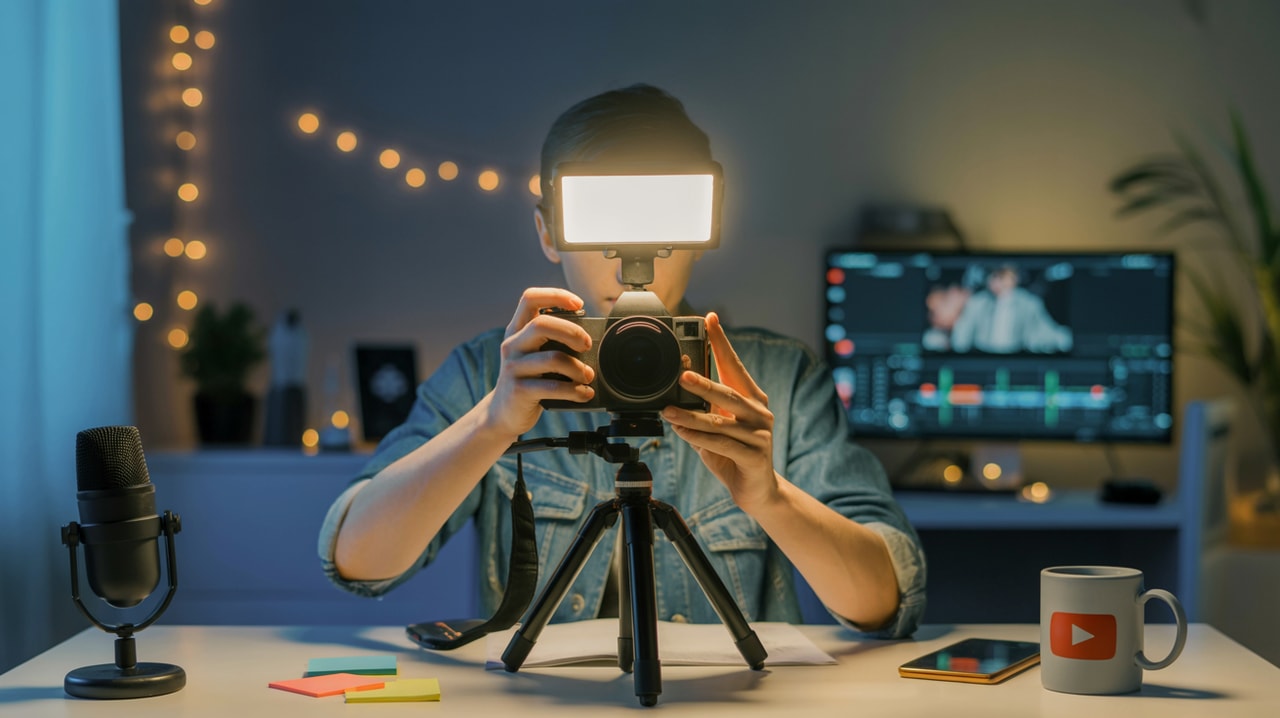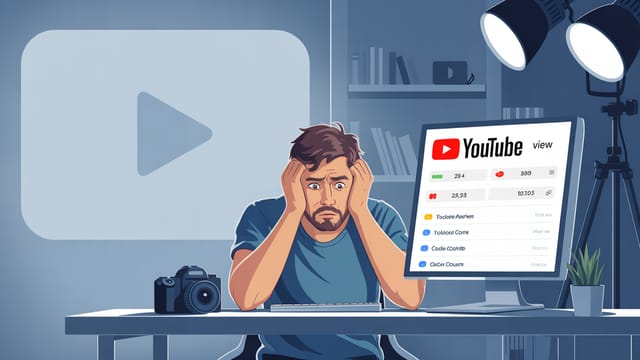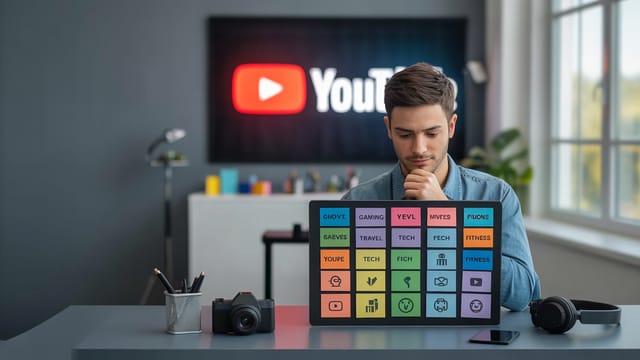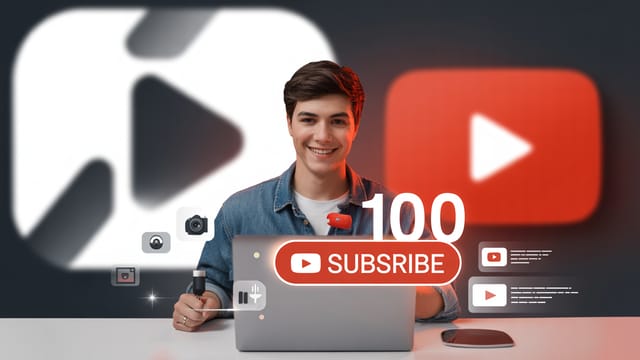
Ready to get your next 10,000 subscribers?
Join thousands of creators who use Subscribr to create faster, better YouTube videos.
How to Film High-Quality YouTube Videos in Low Light
Struggling with dark, grainy video footage on your YouTube channel? You're not alone. Many creators face the challenge of filming in less-than-ideal lighting conditions, leading to inconsistent visual quality that can deter viewers. Overcoming equipment limitations and the technical complexity of camera settings in low light can feel daunting, creating a steep learning curve for those looking to improve their production value.
But what if you could transform your low-light filming from a frustrating challenge into a creative opportunity? This guide will walk you through actionable techniques and gear tips to help you film high-quality YouTube videos, even when the lights are dim.
Why are my YouTube videos so dark?
The most common reason your YouTube videos appear dark and grainy is simply a lack of sufficient light hitting your camera's sensor. Cameras, especially those with smaller sensors like those found in many smartphones or entry-level cameras, require a certain amount of light to produce a clean image. In low light, the camera has to work harder to capture the available light, often increasing its ISO sensitivity. This boost in sensitivity amplifies the signal from the sensor, but it also amplifies noise, resulting in that undesirable grainy look.
Think of it like trying to hear a faint whisper in a noisy room; you have to strain and focus (increase ISO), which also makes the background noise (grain) more noticeable.
How can I make my videos brighter without lights?
While adding lights is the most effective way to combat low light, you can improve your footage without external lighting by optimizing your camera settings and utilizing available natural or practical light sources.
- Maximize your aperture: Your camera's aperture controls how much light enters the lens. A wider aperture (represented by a smaller f-number like f/1.8 or f/2.8) lets in more light. Use the widest aperture your lens allows for in low light situations.
- Lower your frame rate: Shooting at a lower frame rate (like 24 frames per second instead of 30 or 60) allows the camera's shutter to stay open longer for each frame, capturing more light. Be mindful that very low frame rates can introduce motion blur.
- Adjust shutter speed (with caution): Your shutter speed is directly tied to your frame rate for a natural look (typically, shutter speed is 1 over double the frame rate, e.g., 1/48th for 24fps). While you could slow down your shutter speed further to let in more light, this will introduce significant motion blur, which is usually undesirable for video. It's generally better to prioritize a proper frame rate and use other methods for brightness.
- Increase ISO (judiciously): As mentioned, increasing ISO boosts brightness but adds grain. On some cameras, especially newer models with larger sensors, you can push the ISO higher before the noise becomes too distracting. Experiment with your camera to find the highest acceptable ISO setting.
- Utilize natural light: Position yourself near windows during the daytime. The glass acts as a natural diffuser, providing soft, flattering light. Film during the "golden hour" (early morning or late afternoon) when natural light is softer and warmer.
- Leverage practical lights: Look for existing light sources in your environment like lamps, overhead fixtures, or even street lights if filming outdoors at night. Position your subject near these sources to utilize the available light. As highlighted in insights from the
youtube_strategytool, mastering lighting, even with practical sources, is more impactful than just having expensive gear.
What camera sensor is best for low light?
Generally, cameras with larger sensors perform better in low light conditions. This is because larger sensors have bigger pixels, which can gather more light.
- Full-frame sensors: Found in high-end mirrorless and DSLR cameras, these offer the best low-light performance due to their large size.
- APS-C sensors: Common in many mirrorless and DSLR cameras, these also perform well in low light, offering a good balance of performance and cost.
- Micro Four Thirds sensors: Smaller than APS-C, these can still perform reasonably well in low light, especially in newer camera models with improved sensor technology.
- 1-inch type sensors: Found in some compact cameras and high-end smartphones, these offer a noticeable improvement over smaller smartphone sensors but will struggle more in very dark conditions compared to larger sensors.
While a larger sensor is advantageous, remember that lens choice and lighting techniques are equally, if not more, important for achieving good results in low light. A fast lens (with a wide maximum aperture) on a smaller sensor can often outperform a slow lens on a larger sensor in challenging lighting.
Enhancing Production Quality in Dim Environments
Achieving consistent audio and visual quality in low light requires a focused approach that goes beyond just camera settings.
Mastering Exposure and White Balance
In low light, your camera's automatic settings can sometimes struggle to accurately expose your shot and determine the correct white balance, leading to underexposed or color-shifted footage.
- Manual Exposure: Take control by setting your exposure manually. Use your camera's built-in light meter or histogram to help you achieve a balanced exposure without blowing out highlights or crushing shadows. It's often better to slightly underexpose and recover details in editing than to overexpose and lose information.
- Manual White Balance: Fluorescent or mixed lighting in low-light environments can create unnatural color casts. Set your white balance manually using a gray card or a white object in the scene. This ensures accurate colors regardless of the ambient light.
Reducing Noise and Grain
Even with optimal settings, some noise might be unavoidable in low light. Several strategies can help.
- Proper Exposure is Key: The best way to minimize noise is to get the exposure right in-camera. Underexposing and then brightening in post-production will significantly increase visible noise.
- Noise Reduction Software: Video editing software like Adobe Premiere Pro, DaVinci Resolve, and Final Cut Pro have built-in noise reduction tools. There are also dedicated plugins like Neat Video that offer more advanced noise reduction capabilities. Apply noise reduction carefully, as aggressive settings can make your footage look overly smooth and lose detail.
- Shoot in a Flat Picture Profile: If your camera offers picture profiles, consider shooting in a flat profile (like LOG or a neutral profile). These profiles retain more dynamic range, giving you more flexibility to adjust brightness and contrast in post-production with less risk of introducing noise or losing detail. However, these profiles require color grading in editing.
Equipment Selection & Justification for Low Light
While you don't need the most expensive gear to film in low light, certain equipment can make a significant difference.
Lenses: The Importance of a Fast Aperture
Your lens is crucial for low-light performance. A "fast" lens with a wide maximum aperture (low f-number) allows more light to reach the sensor, enabling you to use lower ISO settings and achieve cleaner footage.
- Prime Lenses: Prime lenses (lenses with a fixed focal length) often have wider maximum apertures than zoom lenses and are generally sharper. A 50mm f/1.8 lens is a popular and affordable choice that performs well in low light.
- Zoom Lenses with Constant Aperture: Some higher-end zoom lenses have a constant maximum aperture across their zoom range (e.g., 24-70mm f/2.8). While not as wide as many prime lenses, an f/2.8 constant aperture is still capable in low light and offers the versatility of a zoom.
When choosing a lens, consider the type of videos you create. For talking head videos, a fast prime lens can provide a nice shallow depth of field and excellent low-light performance. For more dynamic content, a versatile zoom lens might be more practical.
Cameras: Sensor Size and ISO Performance
As discussed, sensor size plays a role, but camera models vary in their ISO performance. Research reviews and look for sample footage shot in high ISO to see how different cameras handle noise. Cameras with back-illuminated sensors or stacked sensors often have better low-light performance.
Portable Lighting Solutions (Affiliate Opportunity)
Even with a capable camera and fast lens, adding some light will drastically improve your low-light footage. Fortunately, there are many portable and affordable lighting options available.
- LED Panels: Compact and versatile, LED panels offer adjustable brightness and color temperature. Look for panels with a high Color Rendering Index (CRI) for accurate color representation. Many can be battery-powered, making them highly portable.
- Small Softboxes or Diffusers: Hard light from a bare bulb or small LED panel can be harsh. Using a small softbox or diffuser softens the light, creating more flattering results. You can even use simple diffusion materials like parchment paper in a pinch (safely!).
- Practical Lights with LED Bulbs: Replace traditional bulbs in lamps or fixtures with high-CRI LED bulbs. This allows you to use existing lights in your environment while ensuring better light quality.
Channels like @YCImaging (566K subscribers) demonstrate how to achieve cinematic lighting for self-filmed videos using minimal equipment, often focusing on one-light setups and creative problem-solving. Their videos show that understanding light placement and quality is more important than the sheer number of lights you have.
Lighting for Mood and Message in Low Light
Low light doesn't have to mean poor quality; it can be a powerful tool for setting a mood and enhancing your video's message.
Creating Atmosphere with Shadows
Instead of trying to eliminate all shadows, learn to use them creatively. Shadows can add depth, dimension, and a sense of drama or intimacy to your footage. Experiment with positioning your light source to create intentional shadows that complement your video's tone.
Utilizing Practical Lights for Visual Interest
Lamps, fairy lights, neon signs, or even the glow from a screen can serve as practical lights within your scene. These not only add visual interest but can also act as motivated light sources, making your lighting feel more natural and less artificial.
Color Temperature and Mood
Different light sources have different color temperatures (warm vs. cool).
- Warm Light (around 2700K-3000K): Creates a cozy, intimate, or nostalgic mood. Incandescent bulbs and many practical lights emit warm light.
- Cool Light (around 5000K-6500K): Creates a clean, modern, or sterile mood. Overcast skies and some LED lights emit cool light.
You can mix color temperatures for creative effect (e.g., a warm practical light in the background with cooler key light on your subject), but be mindful of how it affects your overall white balance.
One-Light Setups for Low Light
You don't need a complex multi-light setup for effective low-light filming. A single well-placed light can be incredibly effective.
- Key Light: Your main light source. Position it to the side and slightly in front of your subject to create shape and depth with shadows. Avoid placing the light directly in front of your subject, as this results in flat, uninteresting lighting, a common mistake highlighted by creators like those on the Content Creators channel.
- Using Diffusion: Even with a single light, diffusing it (with a softbox, umbrella, or even a bounce card reflecting onto your subject) will create softer, more flattering light and help reduce harsh shadows.
Channels like @Vuhlandes (509K subscribers) offer "low light cheat codes" demonstrating how to get the most out of any camera in low light situations by focusing on practical tips and techniques rather than expensive gear. Their approach emphasizes creative problem-solving and utilizing available resources effectively.
Overcoming Technical Complexity and Fear
The technical aspects of filming in low light, from understanding aperture and ISO to setting white balance, can feel overwhelming at first. However, breaking it down and practicing is key.
Practice and Experimentation
As advised by experts found via the youtube_strategy tool, the best way to learn lighting is by doing. Set up your camera and subject and experiment with different light sources, positions, and camera settings. Observe how changes impact your image. This hands-on approach will build your intuition and confidence.
Simplifying Your Setup
Don't feel pressured to use complex lighting setups. Start with one light and master its placement and diffusion. Once you understand how a single light shapes your subject, you can gradually introduce additional lights (like a fill light to soften shadows or a backlight to separate your subject from the background) if needed.
Utilizing Camera Assists
Most modern cameras have features to help you with exposure and focus in low light:
- Histograms: A graph that shows the distribution of tones in your image. Use it to ensure you're not clipping highlights or shadows.
- Zebras: Diagonal lines that appear over areas that are overexposed, helping you adjust your settings to retain detail.
- Focus Peaking: Highlights in-focus edges, making it easier to achieve sharp focus in challenging conditions.
Tools & Resources for Low Light Filming
Improving your low-light filming is an ongoing process of learning and experimentation. Platforms like Subscribr can assist creators in various aspects of their YouTube journey, from scriptwriting to understanding channel performance. While Subscribr's core focus is on content strategy and script creation, the principles of analyzing successful content and optimizing for viewer engagement apply across all aspects of video production, including technical quality. By studying channels that successfully film in challenging conditions (which you can identify using tools like youtube_channel_search), you can gain inspiration and practical insights.
Remember, the goal is to create high-quality, engaging content regardless of the lighting conditions. By understanding the principles of light, mastering your camera settings, and utilizing available tools and techniques, you can confidently film compelling YouTube videos even in the dark.





